Decision Making Theories and Application in NHS Trust Context
VerifiedAdded on 2023/06/08
|12
|3789
|50
Essay
AI Summary
This essay provides an overview of decision-making within the Hull and East Yorkshire NHS Trust, focusing on both normative and descriptive aspects. It examines various decision-making theories, including the rational or normative theory, which posits that individuals make logical decisions to maximize personal utility, and the descriptive theory, which characterizes the choices people make. The essay discusses the advantages and disadvantages of individual versus group decision-making, highlighting the importance of understanding the situation, gathering diverse ideas, and evaluating potential solutions. It also addresses the challenges to rational decision-making, such as bounded rationality and the influence of behavioral economics. The analysis emphasizes the need for healthcare managers to adopt a comprehensive and informed approach to decision-making to effectively address complex issues and improve organizational outcomes. Desklib provides a platform for students to access this essay and other resources for their studies.

DECISION MAKING IN THE NHS
Name:
Institution:
Instructor:
Course:
Date:
Name:
Institution:
Instructor:
Course:
Date:
Paraphrase This Document
Need a fresh take? Get an instant paraphrase of this document with our AI Paraphraser
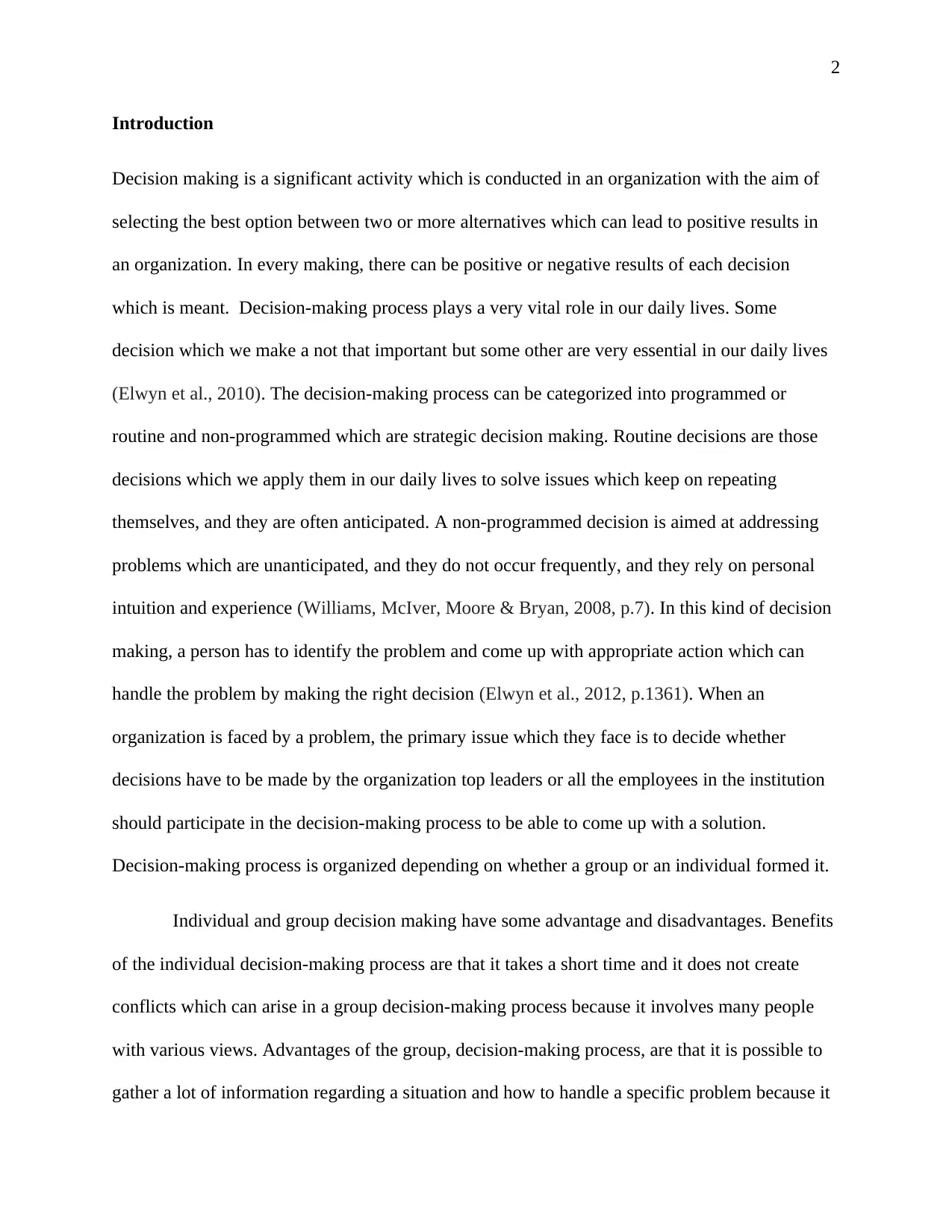
2
Introduction
Decision making is a significant activity which is conducted in an organization with the aim of
selecting the best option between two or more alternatives which can lead to positive results in
an organization. In every making, there can be positive or negative results of each decision
which is meant. Decision-making process plays a very vital role in our daily lives. Some
decision which we make a not that important but some other are very essential in our daily lives
(Elwyn et al., 2010). The decision-making process can be categorized into programmed or
routine and non-programmed which are strategic decision making. Routine decisions are those
decisions which we apply them in our daily lives to solve issues which keep on repeating
themselves, and they are often anticipated. A non-programmed decision is aimed at addressing
problems which are unanticipated, and they do not occur frequently, and they rely on personal
intuition and experience (Williams, McIver, Moore & Bryan, 2008, p.7). In this kind of decision
making, a person has to identify the problem and come up with appropriate action which can
handle the problem by making the right decision (Elwyn et al., 2012, p.1361). When an
organization is faced by a problem, the primary issue which they face is to decide whether
decisions have to be made by the organization top leaders or all the employees in the institution
should participate in the decision-making process to be able to come up with a solution.
Decision-making process is organized depending on whether a group or an individual formed it.
Individual and group decision making have some advantage and disadvantages. Benefits
of the individual decision-making process are that it takes a short time and it does not create
conflicts which can arise in a group decision-making process because it involves many people
with various views. Advantages of the group, decision-making process, are that it is possible to
gather a lot of information regarding a situation and how to handle a specific problem because it
Introduction
Decision making is a significant activity which is conducted in an organization with the aim of
selecting the best option between two or more alternatives which can lead to positive results in
an organization. In every making, there can be positive or negative results of each decision
which is meant. Decision-making process plays a very vital role in our daily lives. Some
decision which we make a not that important but some other are very essential in our daily lives
(Elwyn et al., 2010). The decision-making process can be categorized into programmed or
routine and non-programmed which are strategic decision making. Routine decisions are those
decisions which we apply them in our daily lives to solve issues which keep on repeating
themselves, and they are often anticipated. A non-programmed decision is aimed at addressing
problems which are unanticipated, and they do not occur frequently, and they rely on personal
intuition and experience (Williams, McIver, Moore & Bryan, 2008, p.7). In this kind of decision
making, a person has to identify the problem and come up with appropriate action which can
handle the problem by making the right decision (Elwyn et al., 2012, p.1361). When an
organization is faced by a problem, the primary issue which they face is to decide whether
decisions have to be made by the organization top leaders or all the employees in the institution
should participate in the decision-making process to be able to come up with a solution.
Decision-making process is organized depending on whether a group or an individual formed it.
Individual and group decision making have some advantage and disadvantages. Benefits
of the individual decision-making process are that it takes a short time and it does not create
conflicts which can arise in a group decision-making process because it involves many people
with various views. Advantages of the group, decision-making process, are that it is possible to
gather a lot of information regarding a situation and how to handle a specific problem because it
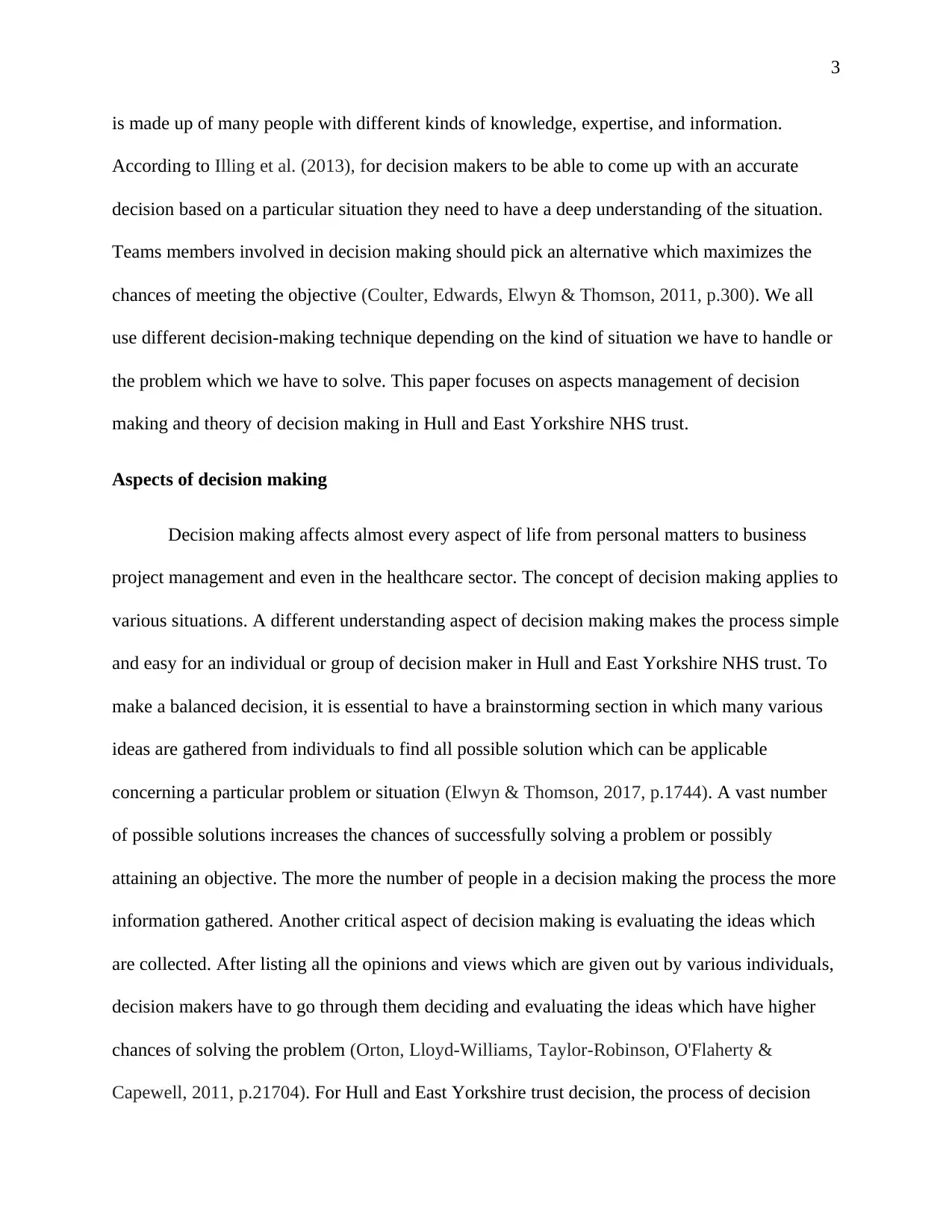
3
is made up of many people with different kinds of knowledge, expertise, and information.
According to Illing et al. (2013), for decision makers to be able to come up with an accurate
decision based on a particular situation they need to have a deep understanding of the situation.
Teams members involved in decision making should pick an alternative which maximizes the
chances of meeting the objective (Coulter, Edwards, Elwyn & Thomson, 2011, p.300). We all
use different decision-making technique depending on the kind of situation we have to handle or
the problem which we have to solve. This paper focuses on aspects management of decision
making and theory of decision making in Hull and East Yorkshire NHS trust.
Aspects of decision making
Decision making affects almost every aspect of life from personal matters to business
project management and even in the healthcare sector. The concept of decision making applies to
various situations. A different understanding aspect of decision making makes the process simple
and easy for an individual or group of decision maker in Hull and East Yorkshire NHS trust. To
make a balanced decision, it is essential to have a brainstorming section in which many various
ideas are gathered from individuals to find all possible solution which can be applicable
concerning a particular problem or situation (Elwyn & Thomson, 2017, p.1744). A vast number
of possible solutions increases the chances of successfully solving a problem or possibly
attaining an objective. The more the number of people in a decision making the process the more
information gathered. Another critical aspect of decision making is evaluating the ideas which
are collected. After listing all the opinions and views which are given out by various individuals,
decision makers have to go through them deciding and evaluating the ideas which have higher
chances of solving the problem (Orton, Lloyd-Williams, Taylor-Robinson, O'Flaherty &
Capewell, 2011, p.21704). For Hull and East Yorkshire trust decision, the process of decision
is made up of many people with different kinds of knowledge, expertise, and information.
According to Illing et al. (2013), for decision makers to be able to come up with an accurate
decision based on a particular situation they need to have a deep understanding of the situation.
Teams members involved in decision making should pick an alternative which maximizes the
chances of meeting the objective (Coulter, Edwards, Elwyn & Thomson, 2011, p.300). We all
use different decision-making technique depending on the kind of situation we have to handle or
the problem which we have to solve. This paper focuses on aspects management of decision
making and theory of decision making in Hull and East Yorkshire NHS trust.
Aspects of decision making
Decision making affects almost every aspect of life from personal matters to business
project management and even in the healthcare sector. The concept of decision making applies to
various situations. A different understanding aspect of decision making makes the process simple
and easy for an individual or group of decision maker in Hull and East Yorkshire NHS trust. To
make a balanced decision, it is essential to have a brainstorming section in which many various
ideas are gathered from individuals to find all possible solution which can be applicable
concerning a particular problem or situation (Elwyn & Thomson, 2017, p.1744). A vast number
of possible solutions increases the chances of successfully solving a problem or possibly
attaining an objective. The more the number of people in a decision making the process the more
information gathered. Another critical aspect of decision making is evaluating the ideas which
are collected. After listing all the opinions and views which are given out by various individuals,
decision makers have to go through them deciding and evaluating the ideas which have higher
chances of solving the problem (Orton, Lloyd-Williams, Taylor-Robinson, O'Flaherty &
Capewell, 2011, p.21704). For Hull and East Yorkshire trust decision, the process of decision
⊘ This is a preview!⊘
Do you want full access?
Subscribe today to unlock all pages.

Trusted by 1+ million students worldwide
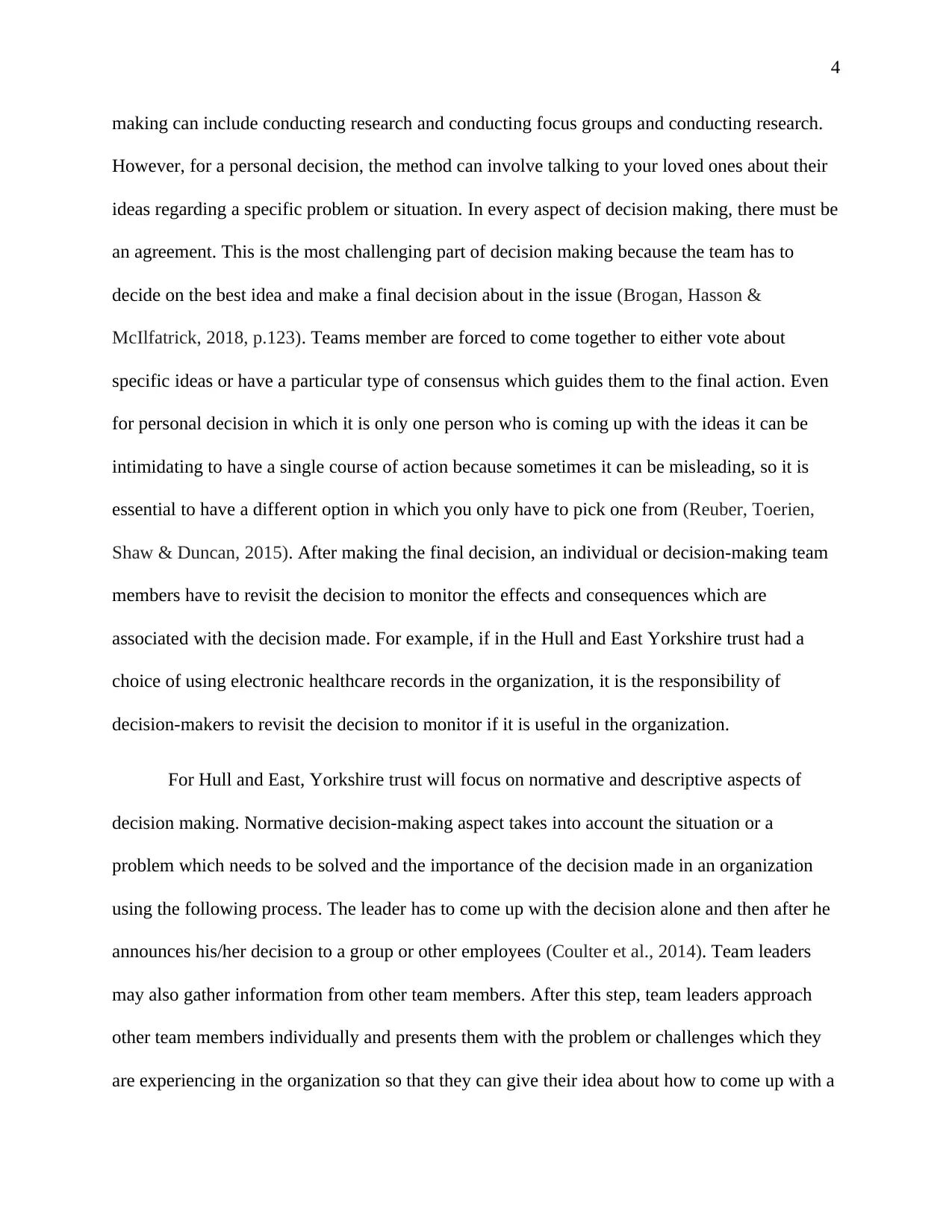
4
making can include conducting research and conducting focus groups and conducting research.
However, for a personal decision, the method can involve talking to your loved ones about their
ideas regarding a specific problem or situation. In every aspect of decision making, there must be
an agreement. This is the most challenging part of decision making because the team has to
decide on the best idea and make a final decision about in the issue (Brogan, Hasson &
McIlfatrick, 2018, p.123). Teams member are forced to come together to either vote about
specific ideas or have a particular type of consensus which guides them to the final action. Even
for personal decision in which it is only one person who is coming up with the ideas it can be
intimidating to have a single course of action because sometimes it can be misleading, so it is
essential to have a different option in which you only have to pick one from (Reuber, Toerien,
Shaw & Duncan, 2015). After making the final decision, an individual or decision-making team
members have to revisit the decision to monitor the effects and consequences which are
associated with the decision made. For example, if in the Hull and East Yorkshire trust had a
choice of using electronic healthcare records in the organization, it is the responsibility of
decision-makers to revisit the decision to monitor if it is useful in the organization.
For Hull and East, Yorkshire trust will focus on normative and descriptive aspects of
decision making. Normative decision-making aspect takes into account the situation or a
problem which needs to be solved and the importance of the decision made in an organization
using the following process. The leader has to come up with the decision alone and then after he
announces his/her decision to a group or other employees (Coulter et al., 2014). Team leaders
may also gather information from other team members. After this step, team leaders approach
other team members individually and presents them with the problem or challenges which they
are experiencing in the organization so that they can give their idea about how to come up with a
making can include conducting research and conducting focus groups and conducting research.
However, for a personal decision, the method can involve talking to your loved ones about their
ideas regarding a specific problem or situation. In every aspect of decision making, there must be
an agreement. This is the most challenging part of decision making because the team has to
decide on the best idea and make a final decision about in the issue (Brogan, Hasson &
McIlfatrick, 2018, p.123). Teams member are forced to come together to either vote about
specific ideas or have a particular type of consensus which guides them to the final action. Even
for personal decision in which it is only one person who is coming up with the ideas it can be
intimidating to have a single course of action because sometimes it can be misleading, so it is
essential to have a different option in which you only have to pick one from (Reuber, Toerien,
Shaw & Duncan, 2015). After making the final decision, an individual or decision-making team
members have to revisit the decision to monitor the effects and consequences which are
associated with the decision made. For example, if in the Hull and East Yorkshire trust had a
choice of using electronic healthcare records in the organization, it is the responsibility of
decision-makers to revisit the decision to monitor if it is useful in the organization.
For Hull and East, Yorkshire trust will focus on normative and descriptive aspects of
decision making. Normative decision-making aspect takes into account the situation or a
problem which needs to be solved and the importance of the decision made in an organization
using the following process. The leader has to come up with the decision alone and then after he
announces his/her decision to a group or other employees (Coulter et al., 2014). Team leaders
may also gather information from other team members. After this step, team leaders approach
other team members individually and presents them with the problem or challenges which they
are experiencing in the organization so that they can give their idea about how to come up with a
Paraphrase This Document
Need a fresh take? Get an instant paraphrase of this document with our AI Paraphraser
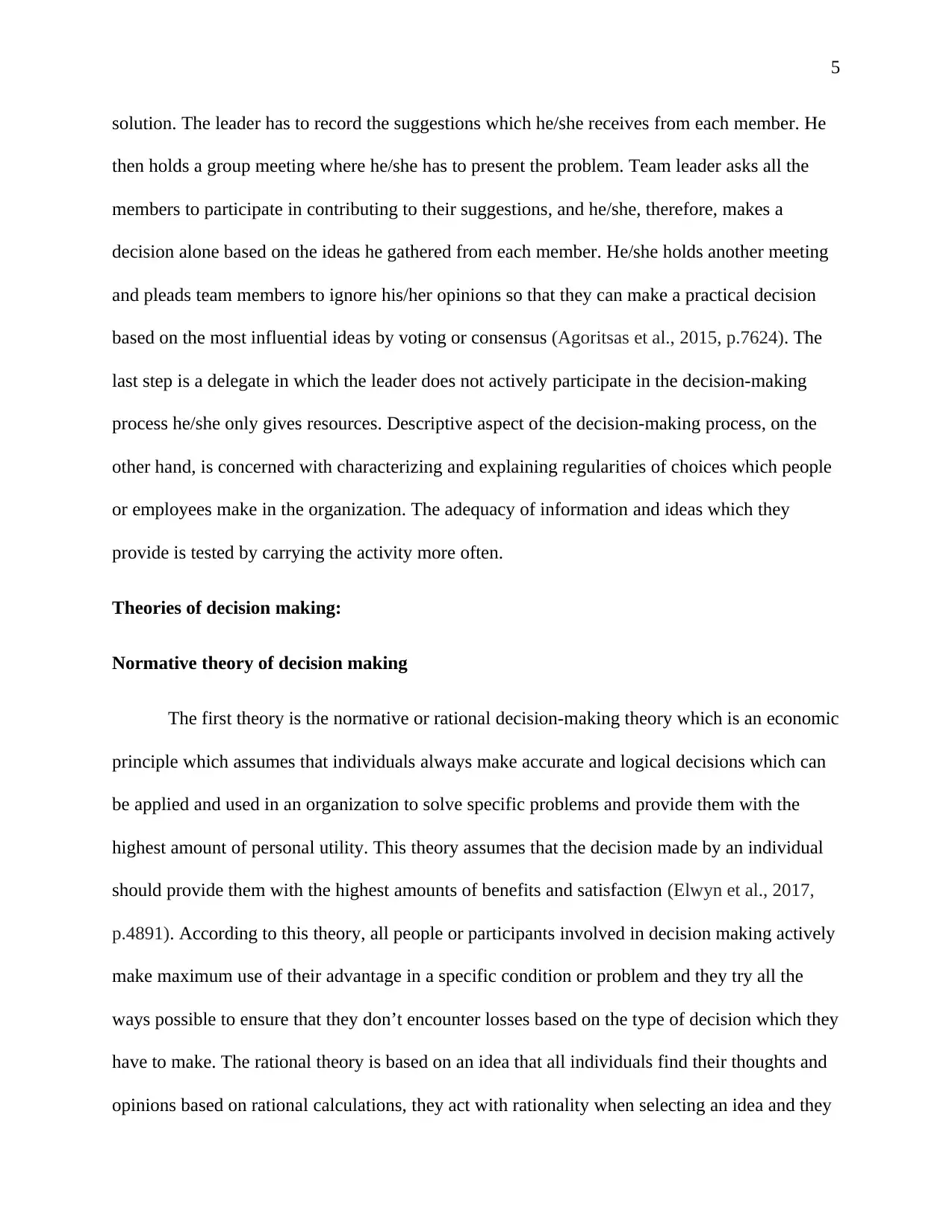
5
solution. The leader has to record the suggestions which he/she receives from each member. He
then holds a group meeting where he/she has to present the problem. Team leader asks all the
members to participate in contributing to their suggestions, and he/she, therefore, makes a
decision alone based on the ideas he gathered from each member. He/she holds another meeting
and pleads team members to ignore his/her opinions so that they can make a practical decision
based on the most influential ideas by voting or consensus (Agoritsas et al., 2015, p.7624). The
last step is a delegate in which the leader does not actively participate in the decision-making
process he/she only gives resources. Descriptive aspect of the decision-making process, on the
other hand, is concerned with characterizing and explaining regularities of choices which people
or employees make in the organization. The adequacy of information and ideas which they
provide is tested by carrying the activity more often.
Theories of decision making:
Normative theory of decision making
The first theory is the normative or rational decision-making theory which is an economic
principle which assumes that individuals always make accurate and logical decisions which can
be applied and used in an organization to solve specific problems and provide them with the
highest amount of personal utility. This theory assumes that the decision made by an individual
should provide them with the highest amounts of benefits and satisfaction (Elwyn et al., 2017,
p.4891). According to this theory, all people or participants involved in decision making actively
make maximum use of their advantage in a specific condition or problem and they try all the
ways possible to ensure that they don’t encounter losses based on the type of decision which they
have to make. The rational theory is based on an idea that all individuals find their thoughts and
opinions based on rational calculations, they act with rationality when selecting an idea and they
solution. The leader has to record the suggestions which he/she receives from each member. He
then holds a group meeting where he/she has to present the problem. Team leader asks all the
members to participate in contributing to their suggestions, and he/she, therefore, makes a
decision alone based on the ideas he gathered from each member. He/she holds another meeting
and pleads team members to ignore his/her opinions so that they can make a practical decision
based on the most influential ideas by voting or consensus (Agoritsas et al., 2015, p.7624). The
last step is a delegate in which the leader does not actively participate in the decision-making
process he/she only gives resources. Descriptive aspect of the decision-making process, on the
other hand, is concerned with characterizing and explaining regularities of choices which people
or employees make in the organization. The adequacy of information and ideas which they
provide is tested by carrying the activity more often.
Theories of decision making:
Normative theory of decision making
The first theory is the normative or rational decision-making theory which is an economic
principle which assumes that individuals always make accurate and logical decisions which can
be applied and used in an organization to solve specific problems and provide them with the
highest amount of personal utility. This theory assumes that the decision made by an individual
should provide them with the highest amounts of benefits and satisfaction (Elwyn et al., 2017,
p.4891). According to this theory, all people or participants involved in decision making actively
make maximum use of their advantage in a specific condition or problem and they try all the
ways possible to ensure that they don’t encounter losses based on the type of decision which they
have to make. The rational theory is based on an idea that all individuals find their thoughts and
opinions based on rational calculations, they act with rationality when selecting an idea and they

6
all have an objective of maximizing their goals. This theory also assumes that all the complex
social scenarios which individuals face are based on the wrong decision which they make and the
actions they take to respond towards a specific situation. Therefore, for social economists to be
able to explain social change all actions, they need to evaluate the rational decision which
individuals have to make (Leng, Clark, Brian & Partridge, 2017). However, many economists do
not believe in the rational theory of decision making because it is based on very many
assumptions. Dissenter has been able to identify that individuals do not always make a rational
decision which can result in positive outcomes of a situation. This is because who are all human
beings and we are prone to errors. Behavioral economics is based on the opinion that people can
always make an irrational decision because of various unavoidable circumstances. This happens
because people do not always get all the significant information they need to make the right
rational decisions.
A rational theory of decision making is faced with a lot of challenges as people argue that
it is made up of many unrealistic assumptions. These assumptions are made to merely possible
choices and predictions based on the amount of information which is available to a decision
maker and the person’s ability to process this information to be able to make the right decisions
(Elwyn et al., 2014, p.270). The theory is also faced with challenges like bounded rationality
which is an idea that a person capability to act rationally is restricted to the amount of
information they are capable of gathering and the cognitive capabilities of their minds. In the
rational theory of decision making, a decision maker can lack the ability and adequate resources
which are significant to be able to arrive at an optimal solution regarding a specific situation or
challenge. Apart from seeking to optimize benefits while reducing costs, people are also willing
to select an optimal decision which will enable them to handle their issues more effectively
all have an objective of maximizing their goals. This theory also assumes that all the complex
social scenarios which individuals face are based on the wrong decision which they make and the
actions they take to respond towards a specific situation. Therefore, for social economists to be
able to explain social change all actions, they need to evaluate the rational decision which
individuals have to make (Leng, Clark, Brian & Partridge, 2017). However, many economists do
not believe in the rational theory of decision making because it is based on very many
assumptions. Dissenter has been able to identify that individuals do not always make a rational
decision which can result in positive outcomes of a situation. This is because who are all human
beings and we are prone to errors. Behavioral economics is based on the opinion that people can
always make an irrational decision because of various unavoidable circumstances. This happens
because people do not always get all the significant information they need to make the right
rational decisions.
A rational theory of decision making is faced with a lot of challenges as people argue that
it is made up of many unrealistic assumptions. These assumptions are made to merely possible
choices and predictions based on the amount of information which is available to a decision
maker and the person’s ability to process this information to be able to make the right decisions
(Elwyn et al., 2014, p.270). The theory is also faced with challenges like bounded rationality
which is an idea that a person capability to act rationally is restricted to the amount of
information they are capable of gathering and the cognitive capabilities of their minds. In the
rational theory of decision making, a decision maker can lack the ability and adequate resources
which are significant to be able to arrive at an optimal solution regarding a specific situation or
challenge. Apart from seeking to optimize benefits while reducing costs, people are also willing
to select an optimal decision which will enable them to handle their issues more effectively
⊘ This is a preview!⊘
Do you want full access?
Subscribe today to unlock all pages.

Trusted by 1+ million students worldwide
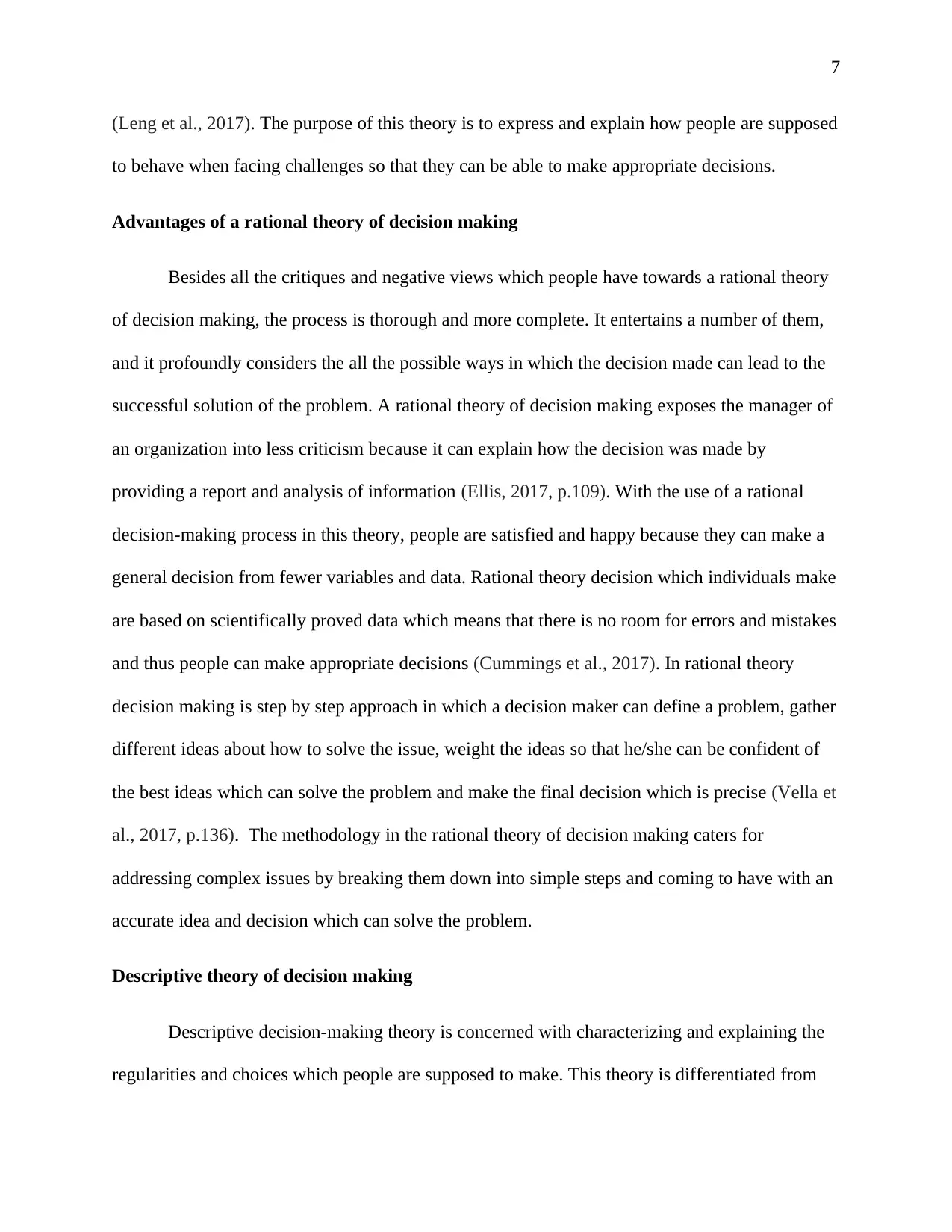
7
(Leng et al., 2017). The purpose of this theory is to express and explain how people are supposed
to behave when facing challenges so that they can be able to make appropriate decisions.
Advantages of a rational theory of decision making
Besides all the critiques and negative views which people have towards a rational theory
of decision making, the process is thorough and more complete. It entertains a number of them,
and it profoundly considers the all the possible ways in which the decision made can lead to the
successful solution of the problem. A rational theory of decision making exposes the manager of
an organization into less criticism because it can explain how the decision was made by
providing a report and analysis of information (Ellis, 2017, p.109). With the use of a rational
decision-making process in this theory, people are satisfied and happy because they can make a
general decision from fewer variables and data. Rational theory decision which individuals make
are based on scientifically proved data which means that there is no room for errors and mistakes
and thus people can make appropriate decisions (Cummings et al., 2017). In rational theory
decision making is step by step approach in which a decision maker can define a problem, gather
different ideas about how to solve the issue, weight the ideas so that he/she can be confident of
the best ideas which can solve the problem and make the final decision which is precise (Vella et
al., 2017, p.136). The methodology in the rational theory of decision making caters for
addressing complex issues by breaking them down into simple steps and coming to have with an
accurate idea and decision which can solve the problem.
Descriptive theory of decision making
Descriptive decision-making theory is concerned with characterizing and explaining the
regularities and choices which people are supposed to make. This theory is differentiated from
(Leng et al., 2017). The purpose of this theory is to express and explain how people are supposed
to behave when facing challenges so that they can be able to make appropriate decisions.
Advantages of a rational theory of decision making
Besides all the critiques and negative views which people have towards a rational theory
of decision making, the process is thorough and more complete. It entertains a number of them,
and it profoundly considers the all the possible ways in which the decision made can lead to the
successful solution of the problem. A rational theory of decision making exposes the manager of
an organization into less criticism because it can explain how the decision was made by
providing a report and analysis of information (Ellis, 2017, p.109). With the use of a rational
decision-making process in this theory, people are satisfied and happy because they can make a
general decision from fewer variables and data. Rational theory decision which individuals make
are based on scientifically proved data which means that there is no room for errors and mistakes
and thus people can make appropriate decisions (Cummings et al., 2017). In rational theory
decision making is step by step approach in which a decision maker can define a problem, gather
different ideas about how to solve the issue, weight the ideas so that he/she can be confident of
the best ideas which can solve the problem and make the final decision which is precise (Vella et
al., 2017, p.136). The methodology in the rational theory of decision making caters for
addressing complex issues by breaking them down into simple steps and coming to have with an
accurate idea and decision which can solve the problem.
Descriptive theory of decision making
Descriptive decision-making theory is concerned with characterizing and explaining the
regularities and choices which people are supposed to make. This theory is differentiated from
Paraphrase This Document
Need a fresh take? Get an instant paraphrase of this document with our AI Paraphraser
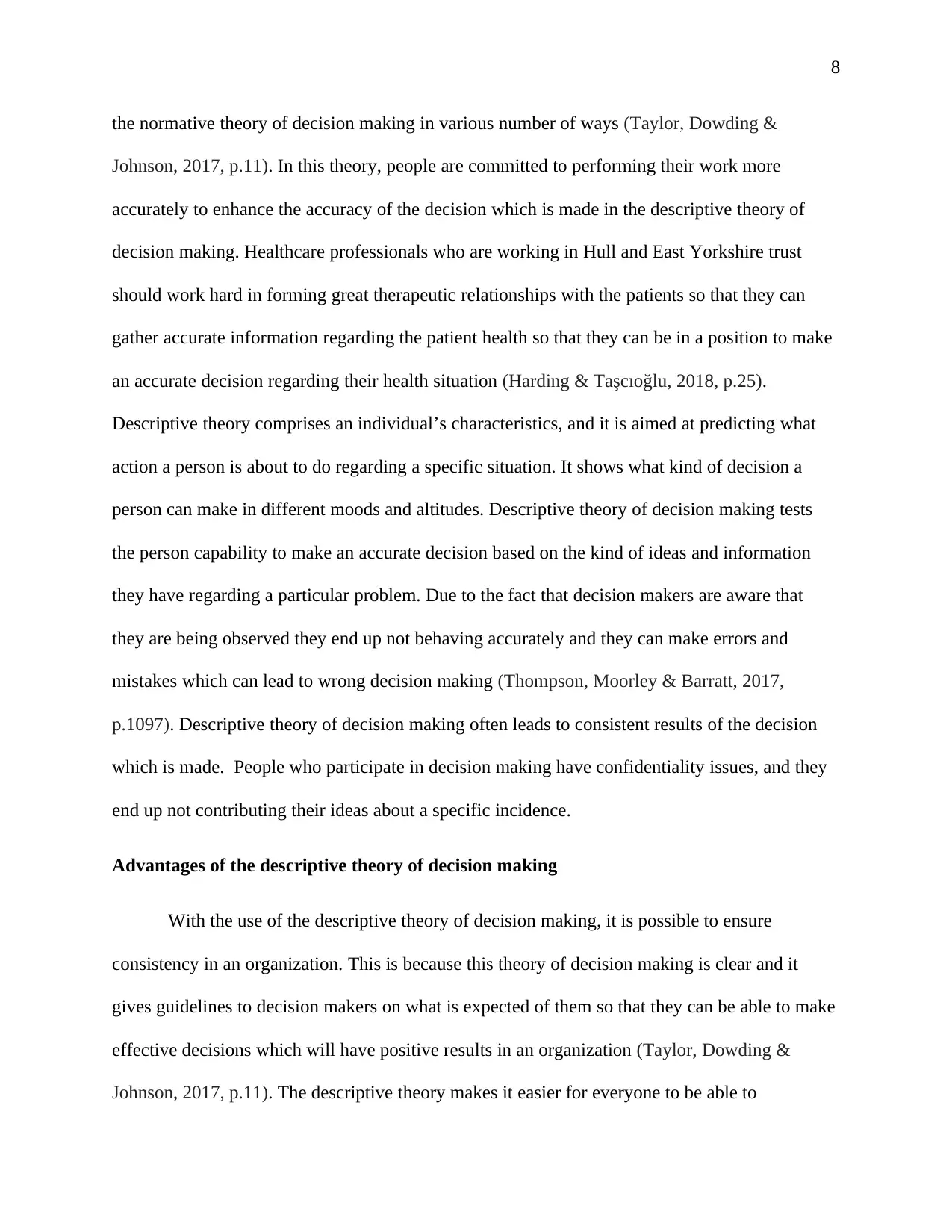
8
the normative theory of decision making in various number of ways (Taylor, Dowding &
Johnson, 2017, p.11). In this theory, people are committed to performing their work more
accurately to enhance the accuracy of the decision which is made in the descriptive theory of
decision making. Healthcare professionals who are working in Hull and East Yorkshire trust
should work hard in forming great therapeutic relationships with the patients so that they can
gather accurate information regarding the patient health so that they can be in a position to make
an accurate decision regarding their health situation (Harding & Taşcıoğlu, 2018, p.25).
Descriptive theory comprises an individual’s characteristics, and it is aimed at predicting what
action a person is about to do regarding a specific situation. It shows what kind of decision a
person can make in different moods and altitudes. Descriptive theory of decision making tests
the person capability to make an accurate decision based on the kind of ideas and information
they have regarding a particular problem. Due to the fact that decision makers are aware that
they are being observed they end up not behaving accurately and they can make errors and
mistakes which can lead to wrong decision making (Thompson, Moorley & Barratt, 2017,
p.1097). Descriptive theory of decision making often leads to consistent results of the decision
which is made. People who participate in decision making have confidentiality issues, and they
end up not contributing their ideas about a specific incidence.
Advantages of the descriptive theory of decision making
With the use of the descriptive theory of decision making, it is possible to ensure
consistency in an organization. This is because this theory of decision making is clear and it
gives guidelines to decision makers on what is expected of them so that they can be able to make
effective decisions which will have positive results in an organization (Taylor, Dowding &
Johnson, 2017, p.11). The descriptive theory makes it easier for everyone to be able to
the normative theory of decision making in various number of ways (Taylor, Dowding &
Johnson, 2017, p.11). In this theory, people are committed to performing their work more
accurately to enhance the accuracy of the decision which is made in the descriptive theory of
decision making. Healthcare professionals who are working in Hull and East Yorkshire trust
should work hard in forming great therapeutic relationships with the patients so that they can
gather accurate information regarding the patient health so that they can be in a position to make
an accurate decision regarding their health situation (Harding & Taşcıoğlu, 2018, p.25).
Descriptive theory comprises an individual’s characteristics, and it is aimed at predicting what
action a person is about to do regarding a specific situation. It shows what kind of decision a
person can make in different moods and altitudes. Descriptive theory of decision making tests
the person capability to make an accurate decision based on the kind of ideas and information
they have regarding a particular problem. Due to the fact that decision makers are aware that
they are being observed they end up not behaving accurately and they can make errors and
mistakes which can lead to wrong decision making (Thompson, Moorley & Barratt, 2017,
p.1097). Descriptive theory of decision making often leads to consistent results of the decision
which is made. People who participate in decision making have confidentiality issues, and they
end up not contributing their ideas about a specific incidence.
Advantages of the descriptive theory of decision making
With the use of the descriptive theory of decision making, it is possible to ensure
consistency in an organization. This is because this theory of decision making is clear and it
gives guidelines to decision makers on what is expected of them so that they can be able to make
effective decisions which will have positive results in an organization (Taylor, Dowding &
Johnson, 2017, p.11). The descriptive theory makes it easier for everyone to be able to
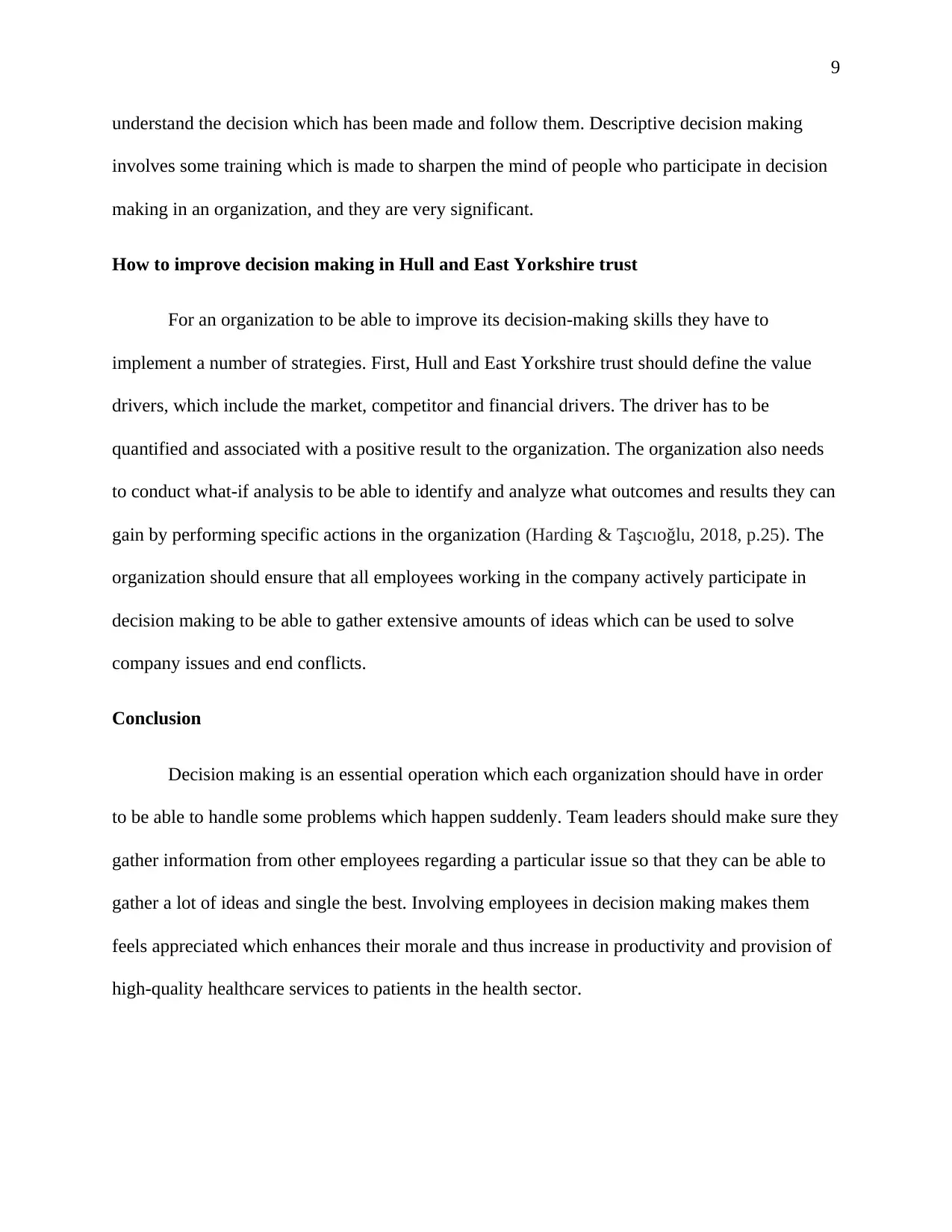
9
understand the decision which has been made and follow them. Descriptive decision making
involves some training which is made to sharpen the mind of people who participate in decision
making in an organization, and they are very significant.
How to improve decision making in Hull and East Yorkshire trust
For an organization to be able to improve its decision-making skills they have to
implement a number of strategies. First, Hull and East Yorkshire trust should define the value
drivers, which include the market, competitor and financial drivers. The driver has to be
quantified and associated with a positive result to the organization. The organization also needs
to conduct what-if analysis to be able to identify and analyze what outcomes and results they can
gain by performing specific actions in the organization (Harding & Taşcıoğlu, 2018, p.25). The
organization should ensure that all employees working in the company actively participate in
decision making to be able to gather extensive amounts of ideas which can be used to solve
company issues and end conflicts.
Conclusion
Decision making is an essential operation which each organization should have in order
to be able to handle some problems which happen suddenly. Team leaders should make sure they
gather information from other employees regarding a particular issue so that they can be able to
gather a lot of ideas and single the best. Involving employees in decision making makes them
feels appreciated which enhances their morale and thus increase in productivity and provision of
high-quality healthcare services to patients in the health sector.
understand the decision which has been made and follow them. Descriptive decision making
involves some training which is made to sharpen the mind of people who participate in decision
making in an organization, and they are very significant.
How to improve decision making in Hull and East Yorkshire trust
For an organization to be able to improve its decision-making skills they have to
implement a number of strategies. First, Hull and East Yorkshire trust should define the value
drivers, which include the market, competitor and financial drivers. The driver has to be
quantified and associated with a positive result to the organization. The organization also needs
to conduct what-if analysis to be able to identify and analyze what outcomes and results they can
gain by performing specific actions in the organization (Harding & Taşcıoğlu, 2018, p.25). The
organization should ensure that all employees working in the company actively participate in
decision making to be able to gather extensive amounts of ideas which can be used to solve
company issues and end conflicts.
Conclusion
Decision making is an essential operation which each organization should have in order
to be able to handle some problems which happen suddenly. Team leaders should make sure they
gather information from other employees regarding a particular issue so that they can be able to
gather a lot of ideas and single the best. Involving employees in decision making makes them
feels appreciated which enhances their morale and thus increase in productivity and provision of
high-quality healthcare services to patients in the health sector.
⊘ This is a preview!⊘
Do you want full access?
Subscribe today to unlock all pages.

Trusted by 1+ million students worldwide
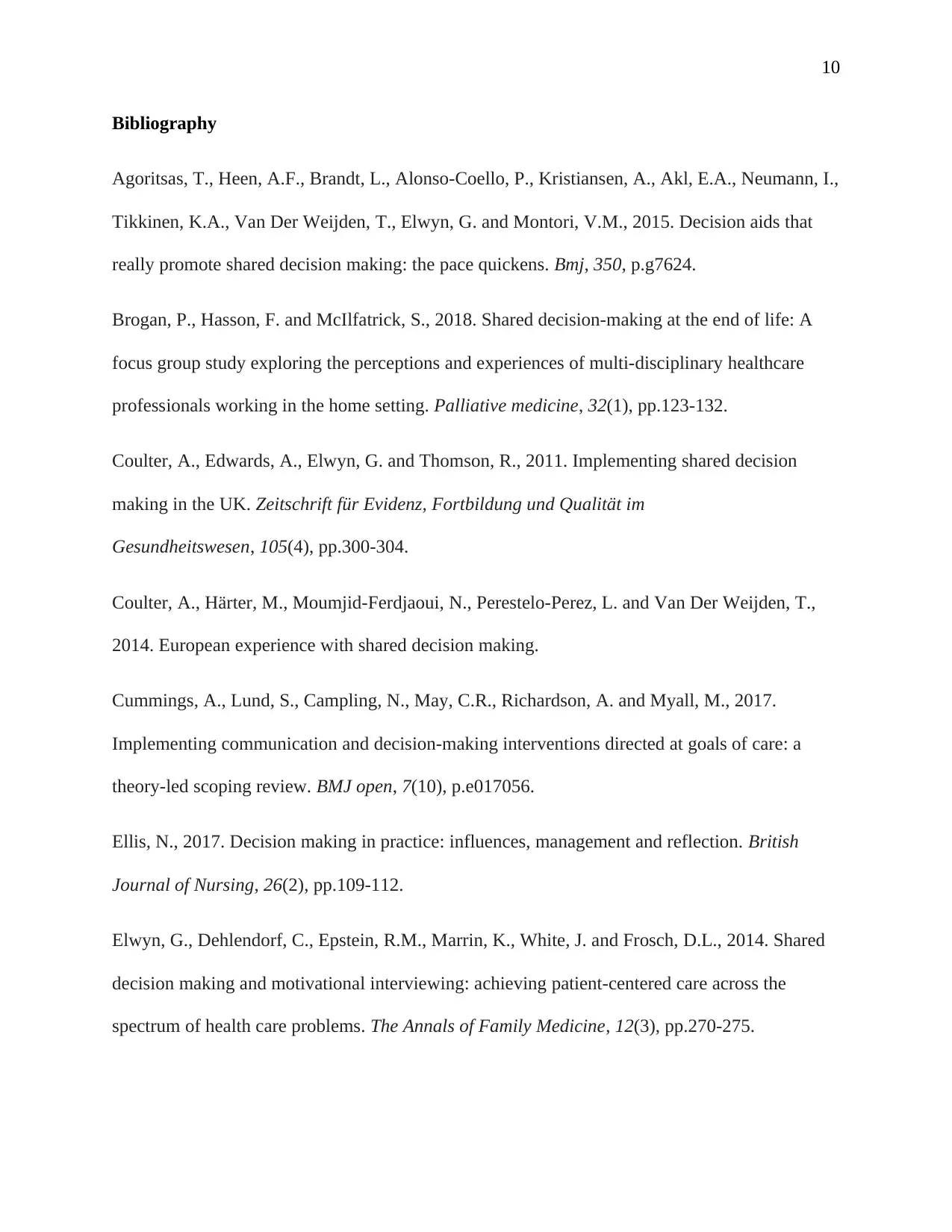
10
Bibliography
Agoritsas, T., Heen, A.F., Brandt, L., Alonso-Coello, P., Kristiansen, A., Akl, E.A., Neumann, I.,
Tikkinen, K.A., Van Der Weijden, T., Elwyn, G. and Montori, V.M., 2015. Decision aids that
really promote shared decision making: the pace quickens. Bmj, 350, p.g7624.
Brogan, P., Hasson, F. and McIlfatrick, S., 2018. Shared decision-making at the end of life: A
focus group study exploring the perceptions and experiences of multi-disciplinary healthcare
professionals working in the home setting. Palliative medicine, 32(1), pp.123-132.
Coulter, A., Edwards, A., Elwyn, G. and Thomson, R., 2011. Implementing shared decision
making in the UK. Zeitschrift für Evidenz, Fortbildung und Qualität im
Gesundheitswesen, 105(4), pp.300-304.
Coulter, A., Härter, M., Moumjid-Ferdjaoui, N., Perestelo-Perez, L. and Van Der Weijden, T.,
2014. European experience with shared decision making.
Cummings, A., Lund, S., Campling, N., May, C.R., Richardson, A. and Myall, M., 2017.
Implementing communication and decision-making interventions directed at goals of care: a
theory-led scoping review. BMJ open, 7(10), p.e017056.
Ellis, N., 2017. Decision making in practice: influences, management and reflection. British
Journal of Nursing, 26(2), pp.109-112.
Elwyn, G., Dehlendorf, C., Epstein, R.M., Marrin, K., White, J. and Frosch, D.L., 2014. Shared
decision making and motivational interviewing: achieving patient-centered care across the
spectrum of health care problems. The Annals of Family Medicine, 12(3), pp.270-275.
Bibliography
Agoritsas, T., Heen, A.F., Brandt, L., Alonso-Coello, P., Kristiansen, A., Akl, E.A., Neumann, I.,
Tikkinen, K.A., Van Der Weijden, T., Elwyn, G. and Montori, V.M., 2015. Decision aids that
really promote shared decision making: the pace quickens. Bmj, 350, p.g7624.
Brogan, P., Hasson, F. and McIlfatrick, S., 2018. Shared decision-making at the end of life: A
focus group study exploring the perceptions and experiences of multi-disciplinary healthcare
professionals working in the home setting. Palliative medicine, 32(1), pp.123-132.
Coulter, A., Edwards, A., Elwyn, G. and Thomson, R., 2011. Implementing shared decision
making in the UK. Zeitschrift für Evidenz, Fortbildung und Qualität im
Gesundheitswesen, 105(4), pp.300-304.
Coulter, A., Härter, M., Moumjid-Ferdjaoui, N., Perestelo-Perez, L. and Van Der Weijden, T.,
2014. European experience with shared decision making.
Cummings, A., Lund, S., Campling, N., May, C.R., Richardson, A. and Myall, M., 2017.
Implementing communication and decision-making interventions directed at goals of care: a
theory-led scoping review. BMJ open, 7(10), p.e017056.
Ellis, N., 2017. Decision making in practice: influences, management and reflection. British
Journal of Nursing, 26(2), pp.109-112.
Elwyn, G., Dehlendorf, C., Epstein, R.M., Marrin, K., White, J. and Frosch, D.L., 2014. Shared
decision making and motivational interviewing: achieving patient-centered care across the
spectrum of health care problems. The Annals of Family Medicine, 12(3), pp.270-275.
Paraphrase This Document
Need a fresh take? Get an instant paraphrase of this document with our AI Paraphraser
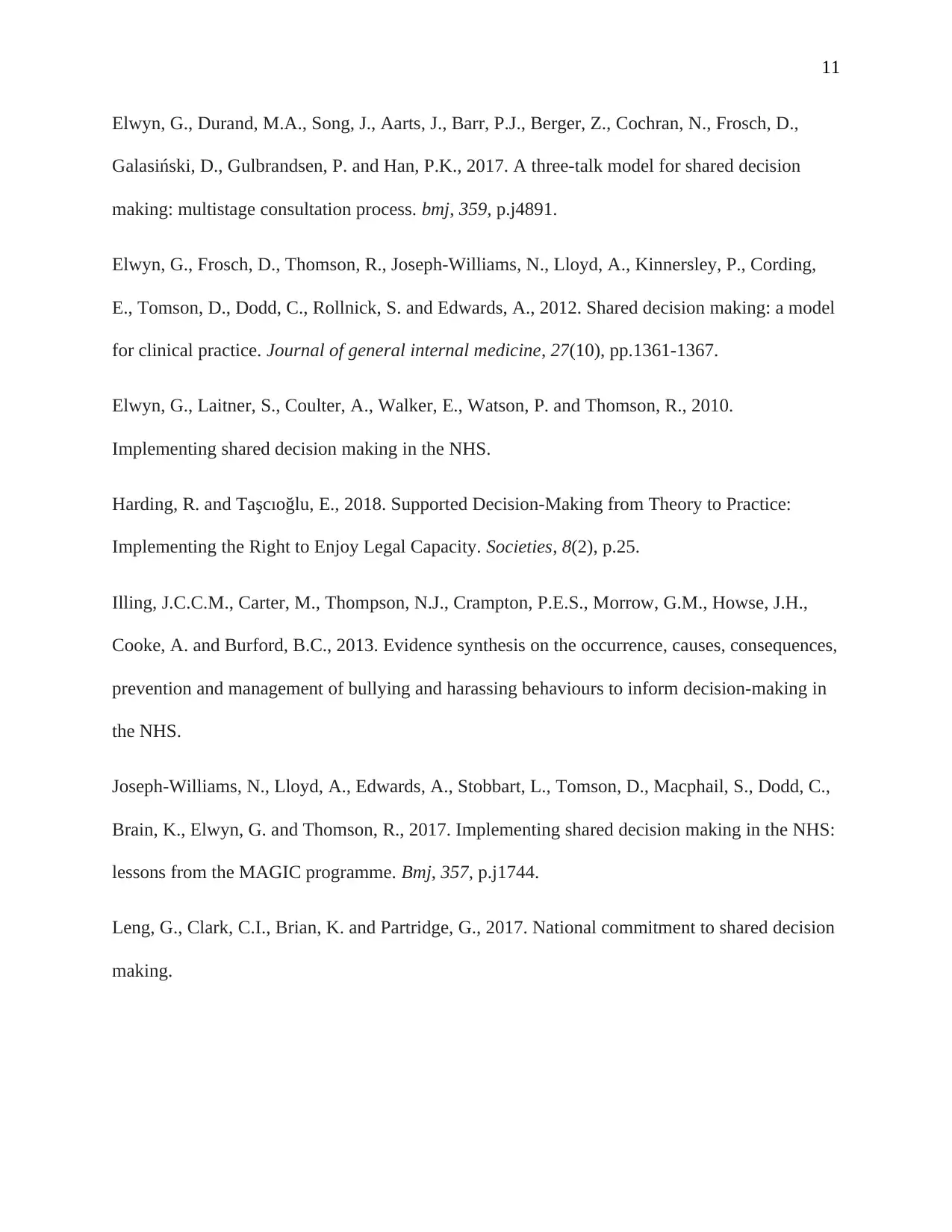
11
Elwyn, G., Durand, M.A., Song, J., Aarts, J., Barr, P.J., Berger, Z., Cochran, N., Frosch, D.,
Galasiński, D., Gulbrandsen, P. and Han, P.K., 2017. A three-talk model for shared decision
making: multistage consultation process. bmj, 359, p.j4891.
Elwyn, G., Frosch, D., Thomson, R., Joseph-Williams, N., Lloyd, A., Kinnersley, P., Cording,
E., Tomson, D., Dodd, C., Rollnick, S. and Edwards, A., 2012. Shared decision making: a model
for clinical practice. Journal of general internal medicine, 27(10), pp.1361-1367.
Elwyn, G., Laitner, S., Coulter, A., Walker, E., Watson, P. and Thomson, R., 2010.
Implementing shared decision making in the NHS.
Harding, R. and Taşcıoğlu, E., 2018. Supported Decision-Making from Theory to Practice:
Implementing the Right to Enjoy Legal Capacity. Societies, 8(2), p.25.
Illing, J.C.C.M., Carter, M., Thompson, N.J., Crampton, P.E.S., Morrow, G.M., Howse, J.H.,
Cooke, A. and Burford, B.C., 2013. Evidence synthesis on the occurrence, causes, consequences,
prevention and management of bullying and harassing behaviours to inform decision-making in
the NHS.
Joseph-Williams, N., Lloyd, A., Edwards, A., Stobbart, L., Tomson, D., Macphail, S., Dodd, C.,
Brain, K., Elwyn, G. and Thomson, R., 2017. Implementing shared decision making in the NHS:
lessons from the MAGIC programme. Bmj, 357, p.j1744.
Leng, G., Clark, C.I., Brian, K. and Partridge, G., 2017. National commitment to shared decision
making.
Elwyn, G., Durand, M.A., Song, J., Aarts, J., Barr, P.J., Berger, Z., Cochran, N., Frosch, D.,
Galasiński, D., Gulbrandsen, P. and Han, P.K., 2017. A three-talk model for shared decision
making: multistage consultation process. bmj, 359, p.j4891.
Elwyn, G., Frosch, D., Thomson, R., Joseph-Williams, N., Lloyd, A., Kinnersley, P., Cording,
E., Tomson, D., Dodd, C., Rollnick, S. and Edwards, A., 2012. Shared decision making: a model
for clinical practice. Journal of general internal medicine, 27(10), pp.1361-1367.
Elwyn, G., Laitner, S., Coulter, A., Walker, E., Watson, P. and Thomson, R., 2010.
Implementing shared decision making in the NHS.
Harding, R. and Taşcıoğlu, E., 2018. Supported Decision-Making from Theory to Practice:
Implementing the Right to Enjoy Legal Capacity. Societies, 8(2), p.25.
Illing, J.C.C.M., Carter, M., Thompson, N.J., Crampton, P.E.S., Morrow, G.M., Howse, J.H.,
Cooke, A. and Burford, B.C., 2013. Evidence synthesis on the occurrence, causes, consequences,
prevention and management of bullying and harassing behaviours to inform decision-making in
the NHS.
Joseph-Williams, N., Lloyd, A., Edwards, A., Stobbart, L., Tomson, D., Macphail, S., Dodd, C.,
Brain, K., Elwyn, G. and Thomson, R., 2017. Implementing shared decision making in the NHS:
lessons from the MAGIC programme. Bmj, 357, p.j1744.
Leng, G., Clark, C.I., Brian, K. and Partridge, G., 2017. National commitment to shared decision
making.
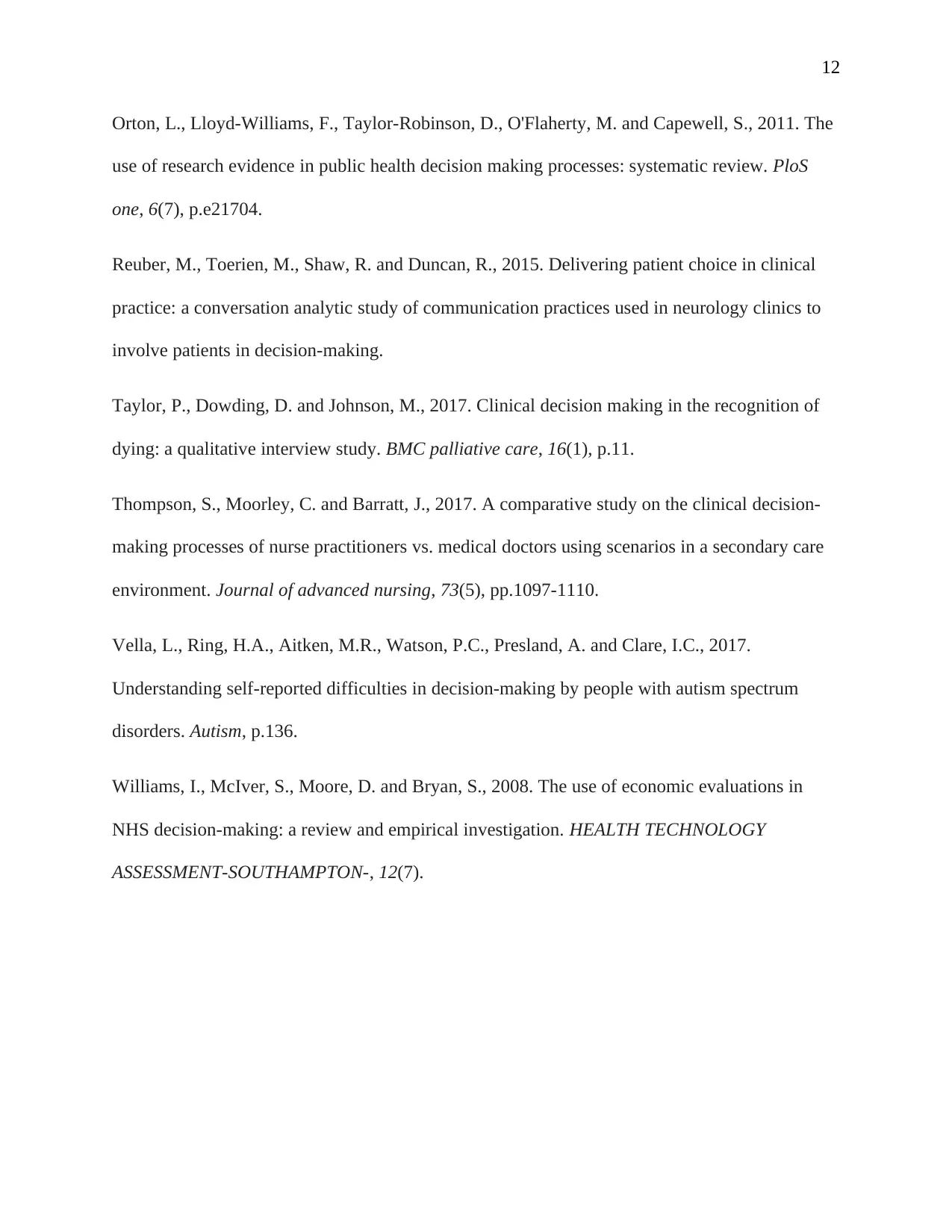
12
Orton, L., Lloyd-Williams, F., Taylor-Robinson, D., O'Flaherty, M. and Capewell, S., 2011. The
use of research evidence in public health decision making processes: systematic review. PloS
one, 6(7), p.e21704.
Reuber, M., Toerien, M., Shaw, R. and Duncan, R., 2015. Delivering patient choice in clinical
practice: a conversation analytic study of communication practices used in neurology clinics to
involve patients in decision-making.
Taylor, P., Dowding, D. and Johnson, M., 2017. Clinical decision making in the recognition of
dying: a qualitative interview study. BMC palliative care, 16(1), p.11.
Thompson, S., Moorley, C. and Barratt, J., 2017. A comparative study on the clinical decision‐
making processes of nurse practitioners vs. medical doctors using scenarios in a secondary care
environment. Journal of advanced nursing, 73(5), pp.1097-1110.
Vella, L., Ring, H.A., Aitken, M.R., Watson, P.C., Presland, A. and Clare, I.C., 2017.
Understanding self-reported difficulties in decision-making by people with autism spectrum
disorders. Autism, p.136.
Williams, I., McIver, S., Moore, D. and Bryan, S., 2008. The use of economic evaluations in
NHS decision-making: a review and empirical investigation. HEALTH TECHNOLOGY
ASSESSMENT-SOUTHAMPTON-, 12(7).
Orton, L., Lloyd-Williams, F., Taylor-Robinson, D., O'Flaherty, M. and Capewell, S., 2011. The
use of research evidence in public health decision making processes: systematic review. PloS
one, 6(7), p.e21704.
Reuber, M., Toerien, M., Shaw, R. and Duncan, R., 2015. Delivering patient choice in clinical
practice: a conversation analytic study of communication practices used in neurology clinics to
involve patients in decision-making.
Taylor, P., Dowding, D. and Johnson, M., 2017. Clinical decision making in the recognition of
dying: a qualitative interview study. BMC palliative care, 16(1), p.11.
Thompson, S., Moorley, C. and Barratt, J., 2017. A comparative study on the clinical decision‐
making processes of nurse practitioners vs. medical doctors using scenarios in a secondary care
environment. Journal of advanced nursing, 73(5), pp.1097-1110.
Vella, L., Ring, H.A., Aitken, M.R., Watson, P.C., Presland, A. and Clare, I.C., 2017.
Understanding self-reported difficulties in decision-making by people with autism spectrum
disorders. Autism, p.136.
Williams, I., McIver, S., Moore, D. and Bryan, S., 2008. The use of economic evaluations in
NHS decision-making: a review and empirical investigation. HEALTH TECHNOLOGY
ASSESSMENT-SOUTHAMPTON-, 12(7).
⊘ This is a preview!⊘
Do you want full access?
Subscribe today to unlock all pages.

Trusted by 1+ million students worldwide
1 out of 12
Related Documents
Your All-in-One AI-Powered Toolkit for Academic Success.
+13062052269
info@desklib.com
Available 24*7 on WhatsApp / Email
![[object Object]](/_next/static/media/star-bottom.7253800d.svg)
Unlock your academic potential
Copyright © 2020–2025 A2Z Services. All Rights Reserved. Developed and managed by ZUCOL.





